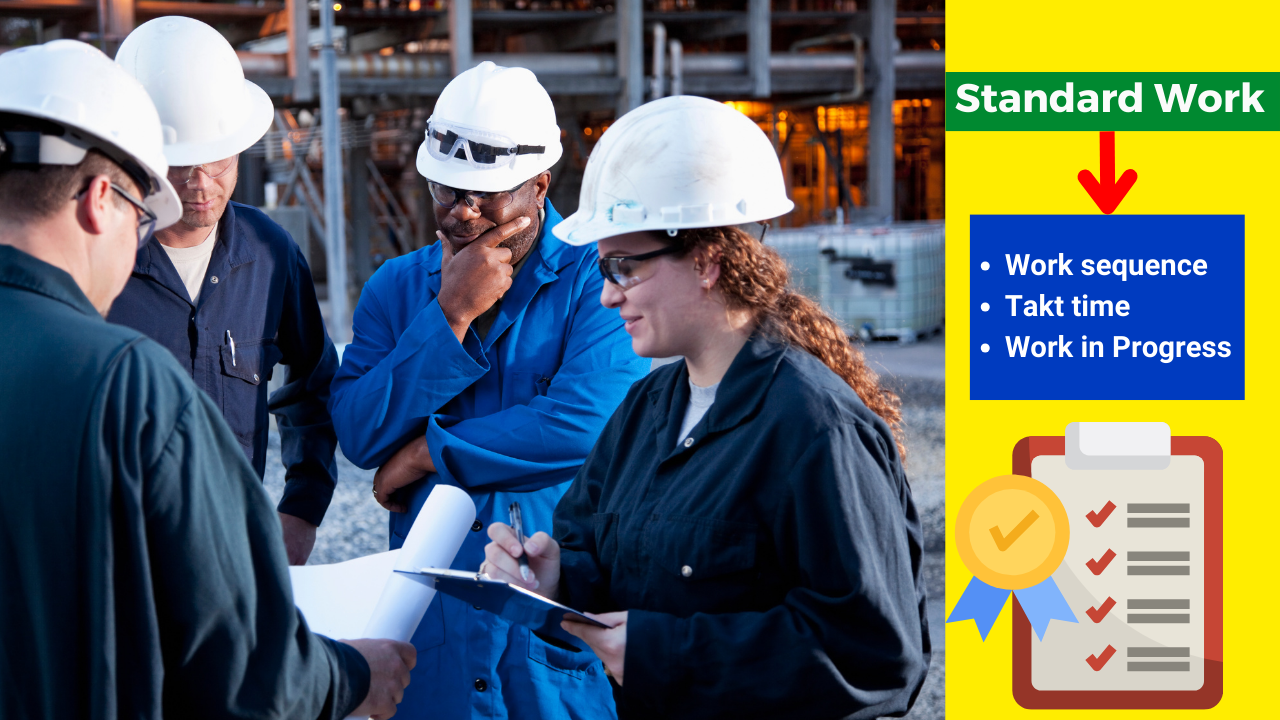Standard Work is the foundational pillar of Lean manufacturing. It’s a powerful tool that transforms chaos into order, inefficiency into productivity, and ambiguity into clarity.
Along with the tools like 5s, kaizen, and kanban, this powerful tool fosters continuous improvement. Standard Work is not about rigidity or following strict procedures, it’s about empowering your team to consistently achieve optimal outcomes.
In this article, I will discuss the fundamentals of Standard Work, explore its origin and elements, and its benefits for any organization, and at the end, we will also understand how to apply standardized work in your organization to make continuous improvement easy.
So, are you ready to optimize your processes and boost productivity at the workplace then let’s get started…
What is Standard Work?
Have you ever seen a pizza shop that makes the most perfect and mouthwatering Pizzas every single time? it’s curious to know how such shops manage to achieve such perfection in pizza every single time.
If you go and see their behind-the-scenes operations you will understand the magic of standardized work in a pizza shop. These shops have created a personalized set of pizza-making steps that everyone working there follows continuously.
Becasue of this standard work system they are consistently producing quality and tasty pizzas for their customers. Standardized work involves creating and maintaining clear and well-defined procedures for performing tasks or activities in a consistent and efficient manner.
Let’s say you are working on an assembly line that produces smartphones, standard work here tells you exactly how to assemble each component, how long each step should take, and even how to inspect quality along the way. That’s how this system helps in optimizing the processes.
Even though this tool is part of Lean manufacturing but can be useful in any type of industry to optimize the processes. You know that the purpose of lean manufacturing is to eliminate waste and improve the efficiency of processes.
That’s what Standard Work helps in doing. By providing step-by-step procedures of how a particular task or process should be done, this tool eliminates waste in the process and maximizes value.

Originally this concept of standardized work came from the Toyota Production System, the father of TPS Taichi Ohno played a significant role in the development of this powerful tool. He emphasized the importance of defining and documenting standard work processes.
Ohno believed that without standardized processes, it was impossible to identify and eliminate waste effectively. He implemented this tool in Toyota and later it became popular in the manufacturing sectors.
In the current scenario, because of its effective results, this tool has been adapted and implemented in different industries like healthcare, service and software development, etc.
So, now the concept of standardizing processes and continuously improving them become valuable in all types of industries. Here are some situations where you must use this tool for better results:
- When introducing a new process or task within your manufacturing or service operation, Standardized work should be developed to establish a baseline for how that process should be performed and everyone involved in the process follows the procedures correctly.
- Standardized work is essential when you are working on continuous process improvement initiatives within your organization to maintain consistent quality of products or services.
- By documenting the current best practices, you make it easier to identify areas for improvement and measure the impact of changes.
- This also serves as the best training tool for new employees or those who are unfamiliar with a specific task or process. It provides a clear and consistent set of instructions that can be used for training purposes.
Elements of Standard Work
There are 3 elements of this powerful tool in Lean Manufacturing. With the help of these 3 elements, this tool ensures consistency, quality, and continuous improvement in the process.
Work sequence:
Standardized work focuses on specifying the precise steps and sequence of activities required to complete a task or process. This includes details such as what needs to be done, how it needs to be done, and in what order those activities are performed to complete the process.
With such clear and standardized work sequences, organizations can easily minimize the variations as well as waste, optimize efficiency, and reduce the risk of errors or defects in the process.
Takt time:
Takt time is the rate at which products or services need to be produced or delivered to meet customer demand. Standard Work should establish a clear understanding of takt time and ensure that the process is designed to meet this demand rate.
It also focuses on reducing cycle time as much as possible while still meeting defined quality standards. This prevents wastes like overproduction or underproduction and maintains proper balance in the process as well as smooth workflow.
Standardized Work in progress (WIP):
WIP limits are the maximum number of items or tasks that can be in progress at any given time in a process. Standardized work also includes guidelines for managing work in the process.
This means specifying the maximum allowable quantity of materials or items at each stage of the process. By limiting WIP, organizations can improve process flow, reduce overproduction, and identify bottlenecks effectively.

Benefits of Standardized Work
- When everyone at the workplace follows standardized processes, it results in consistent product quality. Reduces the chances of defects, reworks, and inconsistencies in the process, which then makes customers satisfied with your products/services.
- Lean focuses on waste elimination and standard work is the most important tool used for waste elimination. By defining the most efficient way to perform a task, you cut down on unnecessary movements, waiting times, and overproduction.
- A standardized way of working helps train new employees and newbies to quickly grasp the documented process and learn from experienced team members. This reduces the time and resources required for onboarding.
- When processes are standardized, communication between team members becomes smoother and this reduces misunderstandings and any type of conflicts.
- A standard work document is a living document that can be updated as you discover better methods or adapt to changing circumstances. It helps you embrace change in an organized manner.
- It uses visual aids like flowcharts, checklists, visual boards, and work instructions to get a clear picture of how things should be done. This makes it easier for employees to track progress, identify bottlenecks, and follow the processes with proper understanding.
- It helps balance the workload among team members preventing the overburdening of some and underutilization of others. This helps the organization to optimize its resources based on actual needs.
- Standardized work often includes the safety procedures and guidelines that need to be followed at the workplace. By following these procedures/guidelines employees can work in a safer work environment, where the risk of accidents or injuries is very low.
- Overall Standardized work serves as the foundation for continuous improvement initiatives. Once the standard is established, teams can regularly review and update it to find a way to make processes even more efficient and effective.
6 Steps to Apply Standardized Work
Now you know all the basic fundamentals of standard work, it’s time to understand the critical aspect of this powerful tool i.e. implementation of standardized work. Let’s see 6 simple steps to implement this at your workplace:
These steps can help you establish and maintain standardized work processes that lead to consistent quality results, reduced variability in the process, and increased productivity within your organization.
1. Start with understanding the current state of the process:
Before you can establish standardized work practices at the workplace, it is important that you thoroughly understand the existing processes and practices. This simply involves observing, documenting, and analyzing how the work is currently being done.
At this step, focus on collecting process-related data like cycle times, work sequences, existing standards, and variations in the process.
You can take the help of visual aids like process maps, and flowcharts to understand the current state of the process clearly.
2. Then identify the key tasks and best practices in the process:
After understanding the current state of the process with the help of visual aids, the next thing you should do is identify the key tasks and best practices in the process that directly contribute to the value stream and ultimately to meeting customer requirements.
Prioritize these tasks or practices based on their importance and impact on the overall process efficiency.
You can pinpoint the use of best practices like a Value stream map to identify non-value-added tasks in the process or poka-yoke to mistake-proof your process.
3. Now create standard work instructions:
Once the key tasks or best practices are identified, determine the optimal sequence and methods for performing each task.
This should include the best practices, the most efficient order of tasks, and the preferred methods or techniques to carry out each task. While doing this ensure safety precautions, productivity, and quality standards.
Visual aids, diagrams, and boards can be useful in making the instructions easy to understand so that all the people working close to the process can easily follow them.
4. Set standard work time and quantity targets:
Determine the ideal time required to complete each task following the established sequence and methods. This time should be based on empirical data and observations, representing the best achievable performance.
Along with this also set the standard quantity targets for production within a specific timeframe or if you are working in the service process then set the standard quantity for the number of people you are going to provide service within a specific timeframe.
5. Train employees for new standardized work practices :
Training is an essential part of standard work implementation, which ensures that all the employees understand and can follow the standardized work instructions properly.
Provide them with hands-on training and allow employees/team members to ask questions and seek clarification.
Make sure that every team member or employee is trained on the new standardized process and they should understand their roles and responsibilities.
For retraining purposes use visual aids, boards, and digital resources to make it easy to understand new practices.
6. Continuously improve:
Standard work is not a one-time effort rather it is an ongoing process. Encourage a culture of continuous improvement by regularly reviewing the standardized work instructions and seeking feedback from the team members who perform the task.
Use this feedback to identify areas of improvement and use tools like root cause analysis for every problem that occurs and make adjustments in standardized work instructions that solve the problem.
Also, use tools like the PDCA cycle or kaizen events to make iterative improvements over time. The goal is to enhance process efficiency, quality, safety, and productivity.
Conclusion
Embracing Standardized work as a fundamental aspect of lean thinking can help organizations navigate challenges, drive sustainable growth, and remain competitive in an increasingly dynamic global marketplace.
In this article, we discussed the Standard Work in detail as a dynamic and evolving process that empowers employees to contribute their expertise and creativity.
The pursuit of operational excellence begins with standardized work, and the sky is the limit for those who dare to dream lean.
By implementing Standard Work organizations can reduce waste, increase efficiency, and enhance product quality, which ultimately drives customer satisfaction.
If you found this article useful then please share it in your network and subscribe to get more such articles every week.






Terrific!! Great post.
The mean challenge is to create the culture when people has its owns believings, and many times we try to load it only in the floor shop people but it needs to be done at the middle staff in order to get sustainability
Thanks again
Thanks for sharing your feedback!